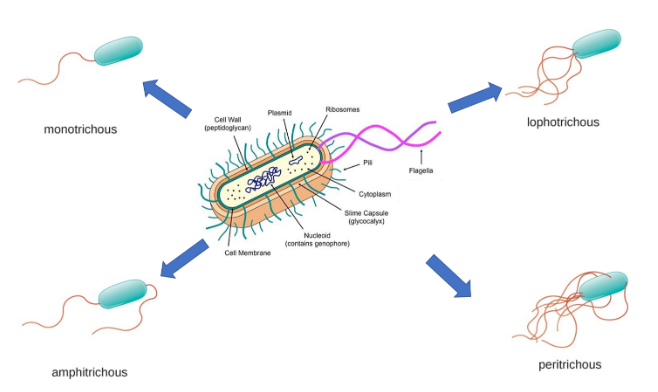
The presence of cluster polar flagella is termed as
A.Monotrichous
B.Amphitrichous
C.Lophotrichous
D.Peritrichous
Answer
570.6k+ views
Hint: Bacteria are prokaryotic microscopic microorganisms that have a few micrometers of length, spherical or rod like in shape. Bacteria have flagella that helps them in their locomotion and movement. Bacteria are classified according to the presence of flagella, or the source of food they intake, the mechanism by which they make food, the temperature they can survive etc.
Complete step by step answer:
There are four types of bacteria that are classified according to the presence of flagella. Those are as follows:
Monotrichous – presence of single polar flagellum. For example – Vibrio cholerae
Amphitrichous – presence of single flagellum on both sides of the body of the bacterium. For example – Alkaligens faecalis
Lophotrichous – presence of cluster of polar flagella at one end or both ends of the body of bacterium. For example – Spirillum sp.
Peritrichous – presence of numerous flagella all over the body of the bacterium. For example – Salmonella typhi
There is another type – atrocious that can be described as a type of bacteria where no polar flagella is present.
Hence, the correct answer is option C. Lophotrichous.

Fig: Bacteria and its classification according to flagella
Note:
Bacterial flagella are made up of flagellin protein and are helical in structure. The base of the flagella is known as the hook which is present near the cell surface. It is attached to the basal body and is enclosed in the envelope of the cell. The flagella spin in a clockwise or anticlockwise manner just like a propeller.
Complete step by step answer:
There are four types of bacteria that are classified according to the presence of flagella. Those are as follows:
Monotrichous – presence of single polar flagellum. For example – Vibrio cholerae
Amphitrichous – presence of single flagellum on both sides of the body of the bacterium. For example – Alkaligens faecalis
Lophotrichous – presence of cluster of polar flagella at one end or both ends of the body of bacterium. For example – Spirillum sp.
Peritrichous – presence of numerous flagella all over the body of the bacterium. For example – Salmonella typhi
There is another type – atrocious that can be described as a type of bacteria where no polar flagella is present.
Hence, the correct answer is option C. Lophotrichous.

Fig: Bacteria and its classification according to flagella
Note:
Bacterial flagella are made up of flagellin protein and are helical in structure. The base of the flagella is known as the hook which is present near the cell surface. It is attached to the basal body and is enclosed in the envelope of the cell. The flagella spin in a clockwise or anticlockwise manner just like a propeller.
Recently Updated Pages
Master Class 12 Business Studies: Engaging Questions & Answers for Success

Master Class 12 Economics: Engaging Questions & Answers for Success

Master Class 12 English: Engaging Questions & Answers for Success

Master Class 12 Maths: Engaging Questions & Answers for Success

Master Class 12 Social Science: Engaging Questions & Answers for Success

Master Class 12 Chemistry: Engaging Questions & Answers for Success

Trending doubts
What is meant by exothermic and endothermic reactions class 11 chemistry CBSE

Which animal has three hearts class 11 biology CBSE

10 examples of friction in our daily life

One Metric ton is equal to kg A 10000 B 1000 C 100 class 11 physics CBSE

1 Quintal is equal to a 110 kg b 10 kg c 100kg d 1000 class 11 physics CBSE

Difference Between Prokaryotic Cells and Eukaryotic Cells




